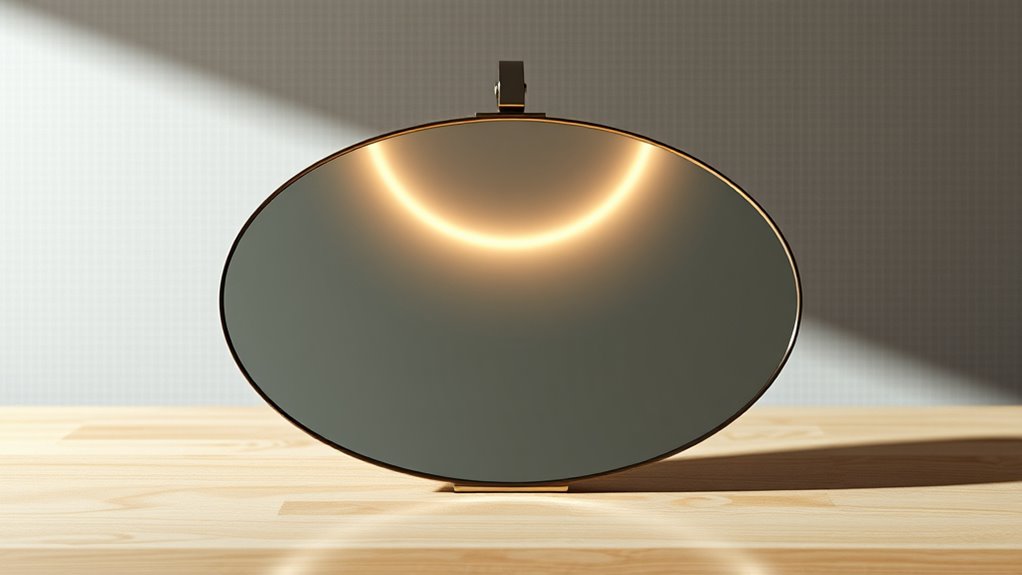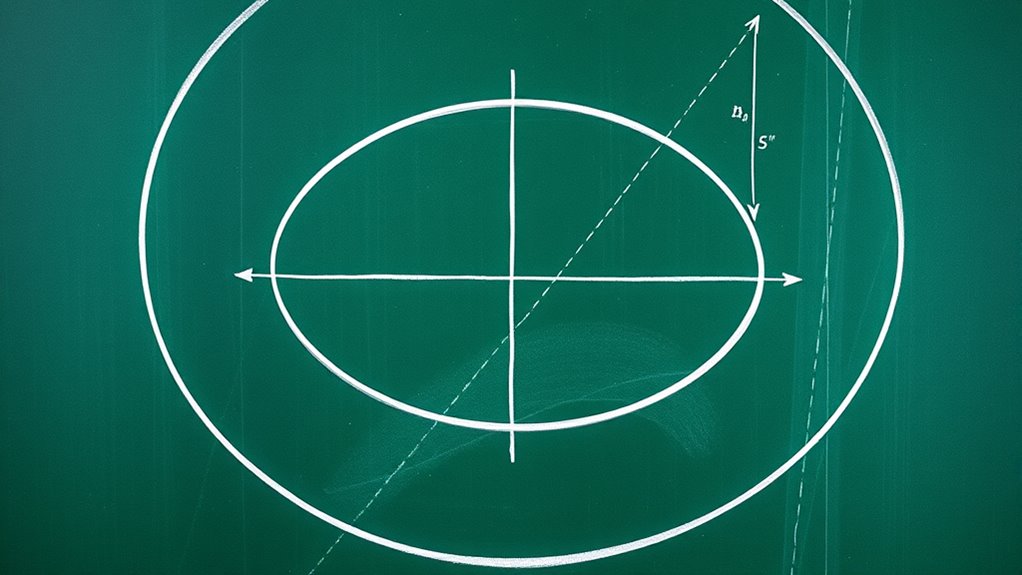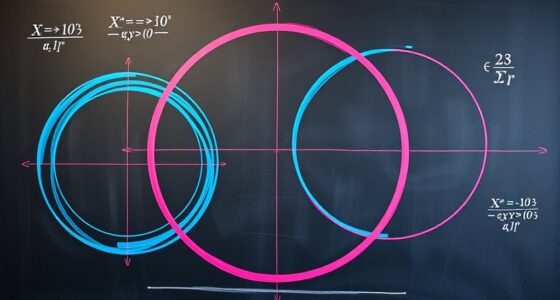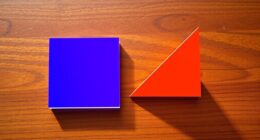Conic sections are special curves formed by slicing a cone at different angles, including parabolas, ellipses, and hyperbolas. You’ll discover that each type has unique features, such as focus, directrix, and eccentricity, which help define their shape and properties. Parabolas are used in satellite dishes and headlights, while ellipses appear in planetary orbits. Exploring their equations and applications reveals how these curves shape our world—continue to uncover more about their fascinating characteristics.
Key Takeaways
- Conic sections are curves formed by slicing a cone at different angles, including circles, ellipses, parabolas, and hyperbolas.
- Each conic has unique geometric properties, such as foci, directrix, and eccentricity, defining their shape and features.
- Parabolas are characterized by a focus and vertex, with a reflective property used in satellite dishes and headlights.
- Ellipses have two foci and a constant sum of distances from any point on the curve to these foci, influencing their shape.
- Conic sections are represented by specific algebraic equations and visualized through graphing, with applications in science and engineering.
What Are Conic Sections? An Overview

Have you ever wondered what conic sections are? They’re the curves formed when a plane slices through a cone at different angles, and their history dates back centuries, with mathematicians studying their properties since ancient Greece. Conic section classification divides these curves into three main types: circles, ellipses, and hyperbolas, each with unique features. Understanding what conic sections are helps explain many real-world phenomena, from planetary orbits to architectural designs. These curves are not just abstract concepts; they have practical applications in engineering, physics, and computer graphics. By grasping the basics of their history and classification, you’ll see how these elegant shapes play a crucial role in both mathematics and everyday life.
The Geometry of Parabolas

You’ll explore how the focus and vertex define a parabola’s shape and position. The latus rectum’s length reveals important geometric properties, while the parabola’s reflective property explains its use in satellite dishes and headlights. Understanding these points helps you grasp the unique geometry that makes parabolas so useful. Additionally, the high precision of projection is essential for applications like home theater projectors, where accurate image reproduction depends on the parabola’s reflective characteristics.
Parabola Focus and Vertex
What exactly defines the shape of a parabola? It’s its focus and directrix, which create the parabola’s symmetry. The parabola is the set of points equidistant from the focus and the directrix. The vertex is the point where the parabola reaches its minimum or maximum, and it lies midway between the focus and directrix. To find the vertex calculation, you measure the distance from the focus to the directrix and locate the midpoint, which becomes the vertex. The parabola’s symmetry ensures that if you fold it along the axis through the focus and vertex, both sides match perfectly. Understanding the focus and vertex helps you grasp the parabola’s fundamental shape and position, laying the groundwork for analyzing its properties and equations. Additionally, recognizing the role of natural materials in designing parabolic reflectors can enhance practical applications of these curves.
Latus Rectum Significance
Ever wondered why the latus rectum is important in understanding a parabola’s shape? It’s a key element in the conic section properties, giving you insight into the parabola’s width and curvature. The length of the latus rectum directly relates to the parabola’s geometric features, helping you visualize its openness. Additionally, understanding trust issues can improve your comprehension of relationship dynamics and the importance of clear, honest communication in defining structural elements like the latus rectum.
Parabolic Reflective Property
The geometry of a parabola gives it a unique reflective property that has practical applications in technology and science. When light or signals hit a parabola’s surface, they reflect to its focus point. This property is essential in optical devices, such as headlights and telescopes, where focusing light improves performance. You’ll also find it in satellite dishes, which use parabolic shapes to direct signals efficiently. When signals from a satellite strike the dish, they reflect toward the receiver at the focus, maximizing signal strength. This reflective property makes parabolas ideal for directing energy precisely and minimizing loss. By understanding this geometry, you can appreciate how parabolic shapes enhance communication, imaging, and lighting technologies. Additionally, the growing and harvesting of chia seeds demonstrates how understanding natural patterns and properties can lead to sustainable and efficient practices.
Exploring Ellipses and Their Properties

When you examine ellipses, you’ll notice they have two special points called foci that determine their shape. The sum of the distances from any point on the ellipse to these foci remains constant. By understanding eccentricity, you’ll see how it influences whether an ellipse appears more elongated or closer to a circle. Additionally, properties like comfort and support solutions can aid in understanding how different shapes and structures can enhance well-being.
Ellipse Foci and Sum
Ellipses are fascinating conic sections characterized by their unique geometric properties, especially involving their foci and the sum of distances. You’ll notice that the foci placement inside the ellipse is essential: the two points determine its shape. When you draw any point on the ellipse, the sum of distances to these foci remains constant. This constant sum defines the ellipse’s boundary. To deepen your understanding, consider these points:
- The foci are always inside the ellipse, not on its edge.
- The sum of distances from any point on the ellipse to both foci is fixed.
- Moving one focus closer to the center alters the shape, making it more elongated.
- The total of these distances remains the same regardless of the position on the ellipse.
This property allows you to identify an ellipse simply by its foci and the constant sum of distances.
Ellipse Eccentricity and Shape
Understanding the shape of an ellipse involves examining how its foci are positioned relative to the center. The eccentricity measurement helps quantify this, indicating how stretched or elongated the ellipse is. An eccentricity of zero describes a perfect circle, while values approaching one show more elongated shapes. As the eccentricity increases, the ellipse shape variations become more noticeable, with the foci moving farther apart. This measurement directly influences the ellipse’s appearance, making it either nearly round or distinctly elongated. By analyzing eccentricity, you can quickly determine the degree of elongation and overall shape. Recognizing these properties enhances your understanding of how ellipses differ from circles and other conic sections, deepening your grasp of their geometric and real-world applications. Additionally, the eccentricity value affects how the ellipse interacts with other geometric shapes and real-world objects, such as planetary orbits or reflective surfaces.
Understanding Hyperbolas and Their Characteristics

Have you ever wondered what makes hyperbolas unique among conic sections? Hyperbolas are defined by their two branches that mirror each other, extending infinitely. Their key features include hyperbola asymptotes, which guide the branches’ directions, and hyperbola vertices, the closest points to the center on each branch. To understand hyperbolas better, consider these points: 1. The asymptotes intersect at the hyperbola’s center, shaping the overall form. 2. The vertices are located along the transverse axis, marking the minimum distance from the center. 3. The distance between vertices determines the hyperbola’s width. 4. The slopes of asymptotes depend on the hyperbola’s orientation and shape. Additionally, understanding the properties of conic sections aids in analyzing hyperbolas more effectively.
The Role of Foci and Directrices in Conic Sections

Foci and directrices are fundamental to understanding the shape and properties of conic sections. Your foci placement determines the unique geometric features of each conic, whether it’s a parabola, ellipse, or hyperbola. For a parabola, the focus is a point where the directrix function helps define the curve: every point on the parabola is equidistant from the focus and the directrix. In ellipses and hyperbolas, the foci influence the overall shape, with the sum or difference of distances to the foci remaining constant. The directrix acts as a reference line that, together with the focus, helps in constructing the conic precisely. Additionally, understanding the eccentricity of a conic provides insight into its specific geometric properties, such as how elongated or circular it appears. By understanding the roles of foci and directrices, you gain insight into the fundamental properties that define each conic section’s form.
Equations and Graphs of Conic Curves

How do you represent conic sections mathematically and visualize their shapes? You use conic equations, which are algebraic expressions defining each curve, and graph plotting to see their forms. To understand these better, consider:
- The standard forms of conic equations for parabolas, ellipses, and hyperbolas.
- How coefficients affect the shape and size of each conic.
- The role of axes and asymptotes in graphing hyperbolas.
- Techniques for rewriting equations into recognizable forms for easier graph plotting.
- The importance of coordinate systems in accurately plotting and analyzing conic sections.
Mastering conic equations helps you visualize each curve accurately, revealing their unique properties and symmetries. Whether plotting by hand or using graphing tools, understanding these equations is essential for analyzing conic sections effectively.
Real-World Applications of Conic Sections

Conic sections are not just abstract mathematical curves; they appear frequently in real-world situations and technological applications. For example, satellite dishes are shaped like parabolas, focusing signals onto the receiver for clearer reception. Similarly, planetary orbits follow elliptical paths, a direct application of conic sections in astronomy. Engineers design satellite dishes with the parabola’s reflective property to efficiently direct signals, while astronomers study planetary orbits to understand celestial mechanics. Ellipses also appear in satellite communication, where the elliptical shape helps optimize signal coverage. By understanding these curves, you can see how conic sections influence many aspects of daily life and advanced technology, from navigation systems to space exploration. Their practical use underscores the importance of these mathematical concepts beyond textbooks. Additionally, the reflective property of parabolas is utilized in designing solar panels to maximize energy absorption.
Visualizing Conic Sections Through Examples

Have you ever wondered what a parabola or an ellipse really looks like? Visualizing conic sections helps you understand their shapes better. You can explore conic section art, which creates stunning images using conic curves, making abstract concepts tangible. To deepen your understanding, try these activities:
Discover the beauty of conic sections through visualization and creative activities.
- Sketch different conic sections based on focus and directrix positions.
- Solve conic section puzzles that challenge you to identify the shape from given parameters.
- Use software tools to generate 3D models of parabolas, ellipses, and hyperbolas.
- Create art projects that incorporate conic sections into designs, highlighting their beauty and symmetry.
- Exploring the geometric properties of conic sections can enhance your comprehension of their unique characteristics.
These examples make conic sections more accessible and engaging, transforming theoretical ideas into visual experiences.
Frequently Asked Questions
How Do Conic Sections Relate to Planetary Orbits?
You see, conic sections are fundamental to understanding planetary trajectories and orbital mechanics. Planets follow elliptical orbits, which are a type of conic section, with the Sun at one focus. This relationship helps you grasp how celestial bodies move consistently along these paths, governed by gravity. Recognizing conic sections in planetary orbits allows you to predict positions and understand the mechanics behind their motion in space.
Can Conic Sections Be Used in Architectural Designs?
You can definitely use conic sections in architectural designs to achieve structural elegance and aesthetic appeal. By incorporating shapes like parabolas, ellipses, and hyperbolas, you create visually striking and stable structures. These curves distribute stress efficiently, enhancing durability. Architects often use conic sections for arches, domes, and facades, blending form and function seamlessly. This approach elevates the overall beauty and strength of your architectural projects.
What Is the Historical Origin of Conic Sections?
Imagine exploring ancient Greek ruins, where you notice curved structures resembling conic sections. The ancient Greek mathematicians, like Apollonius, studied these curves, revealing their geometric origins. They developed the concept of conic sections around 200 BCE, using conics to understand planetary movements. Their work laid the foundation for how we see conic sections today, highlighting their profound historical and mathematical significance rooted in Greek geometric discoveries.
Are There Other Types of Conic Sections Beyond the Three Main Ones?
You might wonder if there are other conic sections beyond the main three. Besides parabolas, ellipses, and hyperbolas, rare conic sections called non-circular conics exist, but they’re less common and often more complex. These include degenerate cases like points, lines, or pairs of lines, which can occur when the conic’s equation simplifies. While unusual, these non-circular conics expand the variety of shapes you can explore in conic sections.
How Do Conic Sections Apply in Modern Technology and Engineering?
Powerful parabolas play a prominent role in modern technology, guiding signals in optical systems and satellite technology. You see, engineers utilize these elegant curves to enhance precision, optimize focus, and improve efficiency. Whether in satellite dishes, telescopes, or laser systems, conic sections help you harness light, sound, and signals, making contemporary communication, navigation, and observation possible. Their mathematical magic truly makes modern marvels more functional and fantastic.
Conclusion
Now that you’ve explored conic sections, you hold the key to understanding shapes that shape our world. With this knowledge, you can see parabolas, ellipses, and hyperbolas everywhere—more than just mathematical figures, they’re the backbone of modern technology and nature’s design. Keep studying them, and you’ll discover secrets so profound they might just change how you see the universe—more astonishing than the stars themselves.









